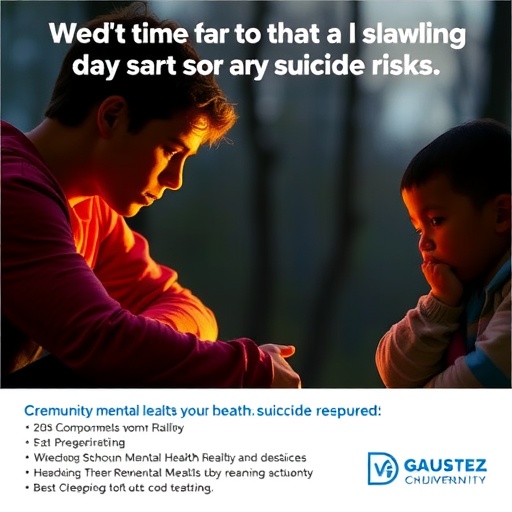In a world increasingly attentive to the mental health of its youngest generation, a groundbreaking study published in BMC Psychiatry in 2025 sheds new light on community-based mental health interventions aimed at reducing suicidal thoughts and behaviors among children and young people (CYP). The systematic review and meta-analysis conducted by Barker, Wang, Huda, and colleagues unveils compelling evidence that such interventions can significantly decrease the rates of suicidal ideation and suicide attempts in this vulnerable demographic, marking a crucial step forward in global suicide prevention efforts.
The research emerges amidst alarming global trends of rising rates of suicidal thoughts, suicide attempts, and non-suicidal self-injury (NSSI) among children and adolescents under 18 years of age. As these trends mount, accessible and scalable solutions are urgently needed. Community-based mental health programs propose one such promising avenue by situating support within schools, families, and broader community settings, potentially overcoming barriers linked to stigma, lack of resources, and accessibility in traditional clinical environments.
This review meticulously synthesizes data collected from four premier electronic research databases—PsycINFO, EMBASE, PubMed, and CINAHL—along with Google Scholar, covering publications from October 2013 to June 2024. Focusing exclusively on controlled trials involving community-based settings, the study aggregates evidence across various modalities including universal and targeted school-based programs, digital interventions, family-centered initiatives, as well as diverse community outreach efforts spanning 12 different countries.
The analysis incorporated 13 eligible studies that met stringent inclusion criteria centered on participants with a mean age below 18 years. Through a rigorous evaluation of methodological quality, the researchers applied both narrative synthesis and quantitative meta-analytic techniques to provide a comprehensive picture of intervention effectiveness. The statistical meta-analysis revealed striking findings: community-based programs reduced suicidal ideation by 43% (Odds Ratio [OR] = 0.57) and suicide attempts by 57% (OR = 0.43), reflecting highly significant results (p < .00001 and p = .004, respectively).
Despite these promising outcomes, the study also underscores ongoing challenges in the field. Data regarding the impact on suicide planning and non-suicidal self-injury were inconclusive, hindered by limited data availability and moderate to high heterogeneity among studies. This gap highlights the complexities inherent in addressing the spectrum of suicidal behaviors and the critical need for more granular research methodologies to decipher these nuances.
Beyond the impressive quantitative outcomes, the study’s findings emphasize the practicality and scalability of community-based interventions. These programs varied widely in their approach, ranging from technology-driven mental health tools engaging youth in digital environments to family-focused psychotherapeutic sessions and school-wide awareness campaigns. This diversity reinforces the versatility of community settings as platforms for mental health promotion and suicide prevention.
Notably, the international scope of the included studies marks a vital stride towards culturally inclusive research. Mental health interventions often risk limited generalizability when confined to specific cultural or geographical contexts. By synthesizing evidence from multiple countries and diverse populations, the authors enhance the relevance and applicability of their conclusions on a global scale, advocating for culturally sensitive program adaptation.
The implications of this research are far-reaching in policy and practice. The documented effectiveness of community-based interventions in diminishing suicidal ideation and attempts supports their integration within national mental health strategies. It signals a call to governments and mental health stakeholders to invest in and prioritize community-focused suicide prevention programming as a fundamental public health measure.
However, Barker and colleagues are careful to temper enthusiasm with calls for further evidence. They stress the urgency of conducting more rigorous, long-term trials that consider cultural variables and sustain follow-up periods to ascertain lasting impact. Additionally, exploring mechanisms behind intervention success and potential differential effects across subpopulations remains a vital frontier for research innovation.
This systematic review and meta-analysis stand as a beacon of hope and scientific rigor in battling the rising tide of youth suicide worldwide. By translating complex data into actionable knowledge, it empowers mental health professionals, educators, and policymakers to implement evidence-based strategies that may save countless young lives.
As the global community continues confronting the multifaceted crisis surrounding youth mental health, this extensive research provides a critical foundation. The integration of community-based mental health interventions promises a path forward that is both practical and profoundly impactful, aligning with the imperative to foster resilient, supported, and hopeful future generations.
Subject of Research:
Community-based mental health interventions targeting the reduction of suicidal thoughts, suicide attempts, and non-suicidal self-injury among children and young people under 18 years.
Article Title:
Community-based mental health interventions for reducing youth suicidal thoughts and behaviours: a systematic review and meta-analysis.
Article References:
Barker, L., Wang, S.S., Huda, M.N. et al. Community-based mental health interventions for reducing youth suicidal thoughts and behaviours: a systematic review and meta-analysis. BMC Psychiatry 25, 1041 (2025). https://doi.org/10.1186/s12888-025-07527-3
Image Credits: AI Generated
DOI:
https://doi.org/10.1186/s12888-025-07527-3




